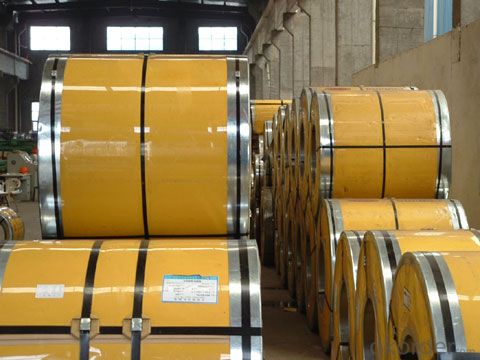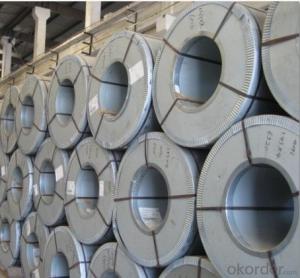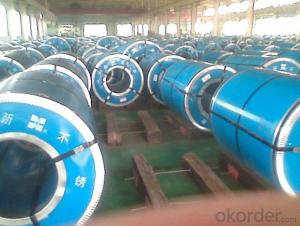Stainless Steel Coil Cold Rolled 304 Surface 2B With Good Quality
- Loading Port:
- Shanghai
- Payment Terms:
- TT OR LC
- Min Order Qty:
- 100 m.t.
- Supply Capability:
- 8000 m.t./month
OKorder Service Pledge
OKorder Financial Service
You Might Also Like
Stainless Steel Coil Cold Rolled 304 Surface 2B With Good Quality
1.Structure of Stainless Steel Coil Cold Rolled 304 Surface 2B With Good Quality
Cold Rolled stainless steel Coil with good quality is one of the raw material of the cold rolled stainless steel Coil, which can be used directly in many places. Stainless Steel (Stainless Steel) is short for acid-proof Stainless Steel, resistant to weak corrosive medium such as air, steam, water, or with a Stainless Steel grade.
2.Main Features of Prefabricated Steel Structure High Building Project
Weldability: The purpose of the different requirement for welding performance are different.1 Kind of tableware generally do not require the performance of welding, even including some pot class enterprise. But the vast majority of products all need raw materials welding performance is good, like the 2 kinds of tableware, thermos flask, steel pipes, water heaters, water dispensers, etc.
3. Stainless Steel Coil Cold Rolled 304 Surface 2B With Good Quality Images


4. Stainless Steel Coil Cold Rolled 304 With Good Quality Specification
The word "stainless steel" is not merely refers to a pure stainless steel, but said more than one hundred kinds of stainless steel industry, the development of each stainless steel has good performance in their specific applications. The key to the success of the first is to make clear purpose, and then determine the correct material. Related to architectural construction applications usually only six types of steel. They contain 17 ~ 22% chromium, good steel contains nickel. Add molybdenum can further improve the atmospheric corrosion resistance, especially containing chloride atmospheric corrosion resistance. Stainless steel often according to the state of organization can be divided intomartensite steel, ferritic steel, austenitic steel, austenitic (two-phase) ferrite stainless steel and precipitation hardening stainless steel, In addition, according to ingredients can be divided into: chromium stainless steel, chromium nickel stainless steel and chromium manganese nitrogen stainless steel, etc.
5. Applications of Stainless Steel Coil 304 With Good Quality
1. Kitchenware: tableware, cookware, Stoves…
2. Food packing: storage cans, food containers…
3. Construction: bridge, roofing, wall, decoration, bathroom accessories…
4. Precision instruments: electrical products, aerospace…
5. Others: automotive parts, machine building, chemical processing, farming…
6.FAQ of Stainless Steel Coil 304 With Good Quality
We have organized several common questions for our clients,may help you sincerely:
①How about your company?
A world class manufacturer & supplier of castings forging in carbon steel and alloy steel,is one of the large-scale professional investment casting production bases in China,consisting of both casting foundry forging and machining factory. Annually more than 8000 tons Precision casting and forging parts are exported to markets in Europe,America and Japan. OEM casting and forging service available according to customer’s requirements.
②How to guarantee the quality of the products?
We have established the international advanced quality management system,every link from raw material to final product we have strict quality test;We resolutely put an end to unqualified products flowing into the market. At the same time, we will provide necessary follow-up service assurance.
③How is the packaging and delivery?
Standard export packing (Coil: waterproof paper + protective steel ring; Circle: wooden box), or as your requirement and the delivery term is based on the project.
- Q:What are the common product forms in which 111 stainless steel strips are available?
- 111 stainless steel strips are commonly available in various product forms to cater to different applications and requirements. Some of the common product forms in which 111 stainless steel strips are available include: 1. Coils: Stainless steel strips in coil form are widely used in industries such as automotive, construction, and appliances. Coils provide convenience for manufacturers as they can be easily processed into different shapes and sizes. 2. Sheets: Stainless steel strips in sheet form are commonly used in architectural applications, kitchen equipment, and decorative purposes. Sheets offer a flat surface that can be easily cut, bent, and formed as per specific requirements. 3. Slit Strips: Slit strips are narrow and long stainless steel strips that are commonly used in applications such as gaskets, seals, and electrical components. They are available in various thicknesses and widths to suit specific needs. 4. Precision Strips: Precision stainless steel strips are manufactured with tight tolerances and high surface quality. These strips are used in critical applications where precise dimensions and superior surface finish are required, such as in the medical and aerospace industries. 5. Flat Bars: Stainless steel strips can also be produced as flat bars. These bars are widely used in structural applications, support frames, and machine components. Flat bars provide strength and stability while offering a larger surface area for load distribution. 6. Foils: Stainless steel strips in foil form are thin and flexible, typically used in packaging, electronic components, and heat exchangers. Foils provide excellent corrosion resistance and can be easily formed into complex shapes. It is important to note that the availability of these product forms may vary depending on the manufacturer and specific industry requirements.
- Q:Can stainless steel strips be used for outdoor applications?
- Yes, stainless steel strips can be used for outdoor applications. Stainless steel is highly resistant to corrosion and rust, making it suitable for various outdoor environments and weather conditions. It offers excellent durability and longevity, making it a popular choice for outdoor structures, equipment, and decorative elements.
- Q:Can stainless steel strips be used in chemical processing plants?
- Chemical processing plants can utilize stainless steel strips. Stainless steel possesses exceptional resistance to corrosion, rendering it extremely appropriate for use in chemical-rich settings. These strips withstand both organic and inorganic chemicals, encompassing acids, alkalis, and salts. Moreover, stainless steel is easily cleaned and maintained, thus being a favored option in hygienic-minded chemical processing plant applications. These strips are also capable of enduring high temperatures, qualifying them for employment in numerous processes like distillation, evaporation, and filtration. In sum, stainless steel strips prove themselves as reliable and long-lasting selections for chemical processing plants due to their corrosion resistance, low maintenance requirements, and capacity to endure harsh surroundings.
- Q:How does the price of stainless steel strips vary?
- The price of stainless steel strips can vary based on factors such as the grade of stainless steel, market demand and supply, production costs, and global economic conditions. Higher-grade stainless steel strips tend to have a higher price due to their superior quality and corrosion resistance. Additionally, fluctuations in raw material prices, such as nickel and chromium, can impact the overall cost of stainless steel strips. Market dynamics and competition also play a role in determining the pricing of stainless steel strips, with supply and demand imbalances affecting the prices.
- Q:Can stainless steel strips be used in water heaters?
- Yes, stainless steel strips can be used in water heaters. Stainless steel is a corrosion-resistant material that can withstand high temperatures and is commonly used in water heater components, including heating elements, tanks, and pipes, due to its durability and resistance to rust and scaling.
- Q:What are the common uses of stainless steel strips in the food manufacturing process?
- Due to their unique properties and hygienic nature, stainless steel strips find wide application in the food manufacturing process. Some typical uses of stainless steel strips in this industry include: 1. Conveyor Belts: Food processing plants commonly employ stainless steel strips as conveyor belts. These strips possess corrosion resistance and can withstand high temperatures, making them suitable for transporting food items throughout various production stages. 2. Food Processing Equipment: Stainless steel strips are utilized in the construction of equipment such as mixers, blenders, grinders, and slicers. The strength and durability of these strips ensure that the equipment can withstand the demanding requirements of food processing while maintaining a clean and hygienic surface. 3. Food Storage and Handling: Stainless steel strips are used to fabricate storage containers, shelves, and racks in food manufacturing facilities. The non-reactive nature of stainless steel guarantees that it won't contaminate food products, thereby preserving their quality and safety. 4. Food Packaging: Stainless steel strips are employed in the production of food packaging materials, including cans, trays, and lids. These strips provide robust and durable packaging, safeguarding the food from external contaminants and ensuring its freshness and longevity. 5. Heat Exchangers: The construction of heat exchangers, which play a crucial role in the food manufacturing process, often involves stainless steel strips. Heat exchangers facilitate the heating or cooling of food products, maintaining the desired temperature for processing, pasteurization, or storage. 6. Sanitary Fittings: Stainless steel strips are used to fabricate sanitary fittings such as pipes, valves, and connectors. These fittings are vital in maintaining a hygienic environment in food processing facilities, as stainless steel is easy to clean, resistant to bacterial growth, and does not contaminate food products. Overall, the widespread usage of stainless steel strips in the food manufacturing process revolves around their corrosion resistance, durability, cleanliness, and ability to preserve food quality and safety.
- Q:Are 111 stainless steel strips suitable for high-temperature furnaces?
- No, 111 stainless steel strips are not suitable for high-temperature furnaces.
- Q:Are 111 stainless steel strips suitable for high-pressure applications?
- Yes, 111 stainless steel strips are suitable for high-pressure applications.
- Q:Are 111 stainless steel strips magnetic?
- Indeed, 111 stainless steel strips possess magnetism. Stainless steel, a collective term for alloys with at least 10.5% chromium content by mass, is known for its resistance to corrosion and tarnishing due to the addition of chromium. Nonetheless, specific grades like the 111 series retain magnetic characteristics. This is attributed to the inclusion of other elements like nickel and manganese in the alloy, enabling magnetism. As a result, 111 stainless steel strips can be attracted to magnets and display magnetic properties.
- Q:How are stainless steel strips different from carbon steel strips?
- Stainless steel strips differ from carbon steel strips primarily in their composition and properties. Stainless steel is a corrosion-resistant alloy that contains a minimum of 10.5% chromium, which forms a protective oxide layer on its surface. This oxide layer prevents rusting and corrosion, making stainless steel strips ideal for applications where durability and resistance to moisture or chemicals are required. Carbon steel, on the other hand, is primarily composed of iron and carbon, with no additional alloying elements like chromium. While carbon steel is generally stronger and more rigid than stainless steel, it is more prone to rust and corrosion. Therefore, carbon steel strips are often used in applications where strength is crucial, while stainless steel strips are preferred for their corrosion resistance.
1. Manufacturer Overview |
|
|---|---|
| Location | |
| Year Established | |
| Annual Output Value | |
| Main Markets | |
| Company Certifications | |
2. Manufacturer Certificates |
|
|---|---|
| a) Certification Name | |
| Range | |
| Reference | |
| Validity Period | |
3. Manufacturer Capability |
|
|---|---|
| a)Trade Capacity | |
| Nearest Port | |
| Export Percentage | |
| No.of Employees in Trade Department | |
| Language Spoken: | |
| b)Factory Information | |
| Factory Size: | |
| No. of Production Lines | |
| Contract Manufacturing | |
| Product Price Range | |
Send your message to us
Stainless Steel Coil Cold Rolled 304 Surface 2B With Good Quality
- Loading Port:
- Shanghai
- Payment Terms:
- TT OR LC
- Min Order Qty:
- 100 m.t.
- Supply Capability:
- 8000 m.t./month
OKorder Service Pledge
OKorder Financial Service
Similar products
New products
Hot products
Hot Searches
Related keywords





























